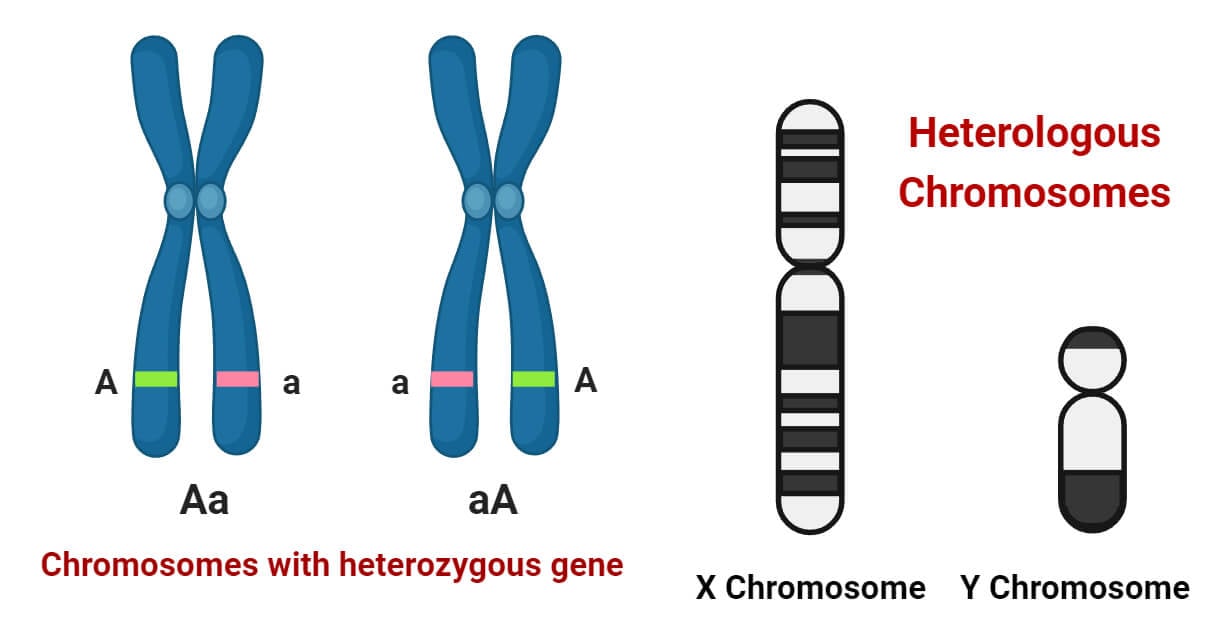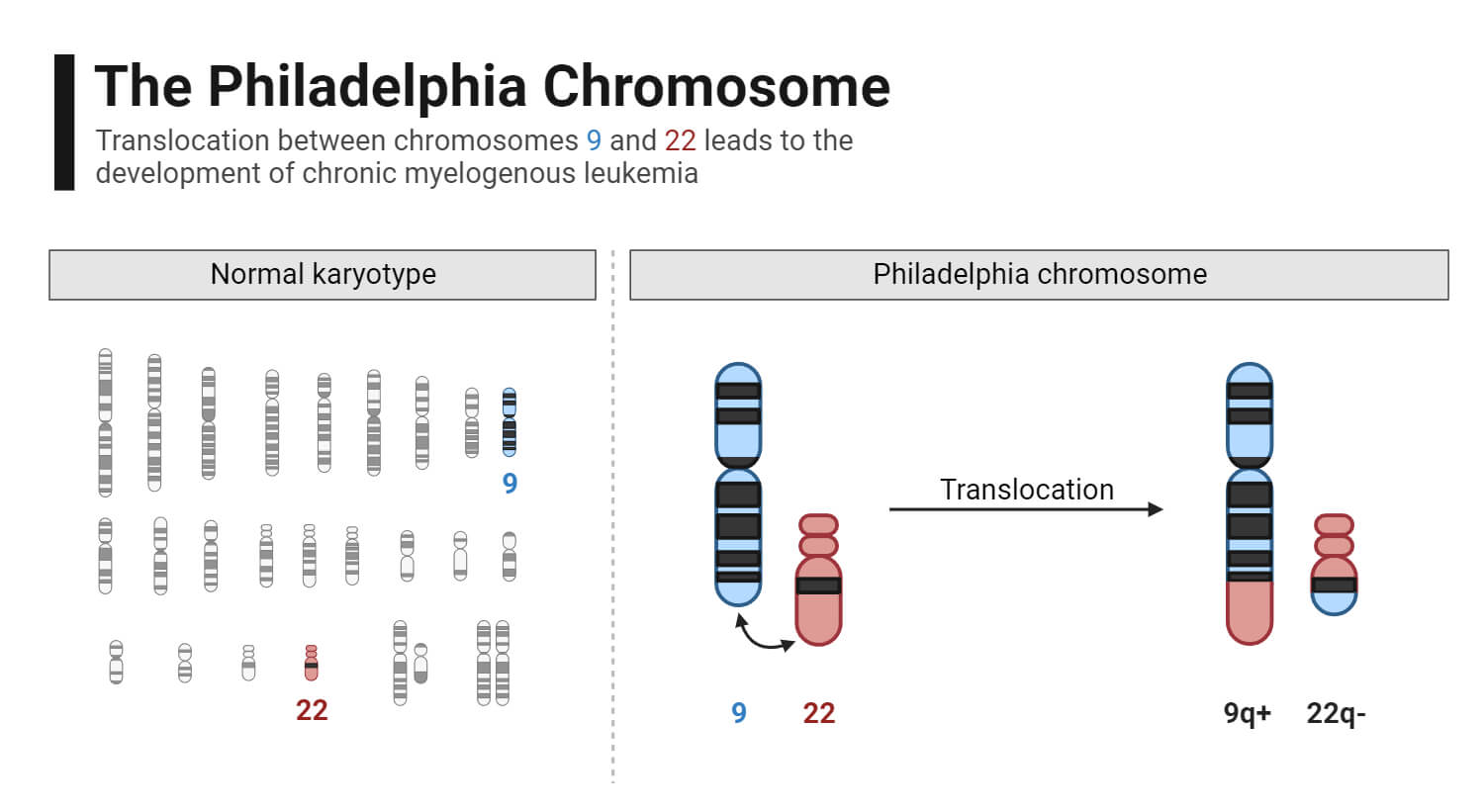Chromosomes carry genetic information within cells and provide instructions for an organism’s growth, development, and functioning.
In diploid organisms, chromosomes are usually present in pairs, with each pair consisting of two homologous chromosomes carrying similar genes. However, there are chromosome pairs that do not share the same gene sequences. These are heterologous chromosomes.

Heterologous chromosomes, also known as non-homologous chromosomes, are pairs of chromosomes that carry different genes or have genes that are arranged differently from one another. These chromosomes differ not only in terms of their genetic content but also in their size, shape, and structural characteristics.
Interesting Science Videos
Difference between Homologous and Heterologous chromosomes
| Topics | Homologous chromosomes | Heterologous chromosomes |
| Definition | Homologous chromosomes are chromosome pairs that contain the same gene sequences. | Heterologous chromosomes are chromosome pairs that have different gene sequences. |
| Pairing | They pair up and undergo recombination during meiosis I. | They do not undergo the same type of pairing and recombination during meiosis. |
| Structure | They share a similar structure including, chromosomal arm lengths and centromere position. | They have different structural characteristics. |
| Examples | Autosomal chromosomes | They share a similar structure, including chromosomal arm lengths and centromere position. |
Heterologous chromosomes pairing
- During the meiosis cell division process, chromosomes pair up and undergo recombination to ensure genetic diversity in offspring. Homologous chromosomes, which carry the same genes, can exchange genetic material through crossover, but it is different for heterologous chromosomes.
- Heterologous chromosomes have different gene sequences, so they do not have the homology required for precise pairing and crossing over.
- Heterologous chromosomes do not undergo the same type of pairing and recombination observed in homologous chromosomes during meiosis.
- Heterologous chromosomes tend to behave independently during meiosis, maintaining their separate genetic identities.
- The lack of pairing and recombination between heterologous chromosomes helps maintain the distinct genetic identities of different chromosome pairs and contributes to genetic diversity among offspring.
- While most of the time, heterologous chromosomes do not exhibit the pairing and recombination as seen in homologous chromosomes, there are exceptions to this behavior among different species.
- In some cases, certain regions of heterologous chromosomes may show limited homology and may be able to pair and recombine to a small extent. For example, in X and Y sex chromosomes in mammals, crossing over occurs in small regions.
- The behavior of chromosomes during meiosis can vary widely among different species and even among different individuals within a species. Different factors, such as genetic distance and sequence similarity, can influence the pairing and recombination between heterologous chromosomes.
Heterologous chromosomes Example: X and Y chromosomes
- In the XX/XY sex chromosomal system found in many mammals, including humans, a small region called the pseudoautosomal region (PAR) exists on both the X and Y chromosomes.
- This PAR contains homologous sequences that allow for pairing and recombination between the non-homologous X and Y chromosomes during meiosis.
- This unique feature allows genetic exchange between the X and Y heterologous chromosomes in a specific region, contributing to diversity while also maintaining the crucial functions of the sex chromosomes.
- The PAR-mediated crossing over between X and Y chromosomes can lead to the exchange of alleles in this region. However, the rest of the X and Y chromosomes usually do not undergo pairing and crossing over.
Heterologous Chromosomes and Translocation
Heterologous chromosomes are often associated with certain chromosomal aberrations, such as translocations. These anomalies disrupt the normal structure and function of genes, leading to genetic disorders and diseases.

Translocation is a process that occurs when chromosomes break, and the fragmented pieces re-attach to different chromosomes. This occurs between heterologous chromosomes. Translocations involving heterologous chromosomes can cause severe effects, leading to the development of various cancers and other genetic diseases.
Understanding and studying chromosomal translocations can be helpful in the diagnosis of several related genetic diseases.
Significance of Heterologous Chromosomes
- Heterologous chromosomes have different gene sequences which contribute to genetic diversity by maintaining distinct genetic identities within chromosome pairs.
- The lack of pairing and recombination helps maintain the unique genetic identities of different chromosome pairs.
- Genetic diversity resulting from heterologous chromosomes enhances the potential for adapting to different conditions.
- The pseudoautosomal regions (PARs) in X and Y sex chromosomes allow limited pairing and recombination, contributing to genetic diversity and proper chromosome segregation.
- Heterologous chromosomes are often associated with chromosomal abnormalities so it helps us to understand the genetic basis of various diseases and disorders.
References
- Eijpe, M., & Baarends, W. M. (2011). The X and Y chromosome in meiosis: How and why they keep silent. Asian Journal of Andrology, 13(6), 779-780. https://doi.org/10.1038/aja.2011.93
- Gong, Z., Liu, X., Tang, D., Yu, H., Yi, C., Cheng, Z., & Gu, M. (2010). Non-homologous chromosome pairing and crossover formation in haploid rice meiosis. Chromosoma, 120(1), 47–60. doi:10.1007/s00412-010-0288-3
- https://pediaa.com/difference-between-homologous-and-non-homologous-chromosomes/
- https://www.genome.gov/genetics-glossary/Translocation
- Kauppi, L., Jasin, M., & Keeney, S. (2012). The tricky path to recombining X and Y chromosomes in meiosis. Annals of the New York Academy of Sciences, 1267, 18. https://doi.org/10.1111/j.1749-6632.2012.06593.x
- Mangs, A. H., & Morris, B. J. (2007). The Human Pseudoautosomal Region (PAR): Origin, Function and Future. Current Genomics, 8(2), 129-136. https://doi.org/10.2174/138920207780368141
- Wilson Sayres, M. A. (2017). Pseudoautosomal Linkage, Region ☆. Reference Module in Life Sciences. doi:10.1016/b978-0-12-809633-8.06975-2

How to printout printer-friendly articles without ads?
You can use ad blocker and copy the content in the word file and print it out. Thanks, we will have the PDF version of all the notes also soon.